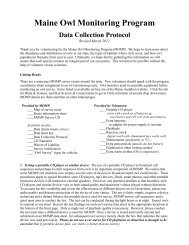Focus Species Forestry - Maine Audubon
Focus Species Forestry - Maine Audubon
Focus Species Forestry - Maine Audubon
Create successful ePaper yourself
Turn your PDF publications into a flip-book with our unique Google optimized e-Paper software.
Spotted Salamander<br />
Distribution: Eastern U.S. except the southeast coastal<br />
plain, north to southern Ontario, Quebec, and Canada.<br />
<strong>Maine</strong> <strong>Focus</strong> Region: Statewide<br />
Home Range/Movement: Most spend adult life within<br />
1,000 feet of breeding pools<br />
Food: Feeds on earthworms, insects, spiders, and slugs and<br />
other invertebrates found in rotting wood and subterranean<br />
tunnels<br />
Special Habitat Needs: Breeds in seasonal or semipermanent,<br />
fishless pools (vernal pools)<br />
Management:<br />
In April or May survey for vernal pools, which usually can be identified by the presence of egg masses.<br />
Manage forest cover and protect soils around vernal pools as described in the vernal pools management<br />
guide (Section 5).<br />
Comments: 6-8 in. long and dark brown to blue-black with bright yellow spots, the spotted salamander is easily<br />
identified. It is most often seen as it migrates to vernal pools during the spring breeding season from mid March to<br />
late April on warm, rainy nights. Oval, generally fist-sized or smaller masses of up to 200 eggs surrounded by a<br />
thick gelatinous envelope are attached to fallen branches. Egg masses may be milky white or clear, but often turn<br />
greenish with algae. Eggs hatch in 1-2 months. Transformation from aquatic larvae to terrestrial juveniles with<br />
lungs takes place 2.5-3 months later. Adults spend most of their life in the forest floor but often emerge on moist<br />
nights to search for prey. Habitat loss from development near pools is the greatest threat to spotted salamanders. Its<br />
close relative the blue-spotted salamander has similar habits.<br />
Habitat Use<br />
Aspen-Birch<br />
Forest Ecosystems<br />
Northern<br />
Hardwoods Oak-Pine Hemlock Spruce-Fir<br />
N. White<br />
Cedar<br />
R S I M R S I M L R S I M L I M L R S I M L I M L<br />
Special-value<br />
Habitats<br />
Riparian/<br />
Wetland Vernal<br />
Forest Pool<br />
R Regeneration and seedlings Mx Mixed conifer-deciduous <strong>Focus</strong> habitat<br />
S Saplings and small poles U Understory present Other habitat<br />
I Intermediate-aged forest C Cavity tree or snag Little/no use<br />
M Mature forest<br />
L Late-successional forest<br />
References: Boone and Krohn 1998, Calhoun 2003, Calhoun and deMaynadier 2003, DeGraaf and Yamasaki<br />
2001, Smith 1999<br />
56<br />
<strong>Focus</strong> <strong>Species</strong> <strong>Forestry</strong>



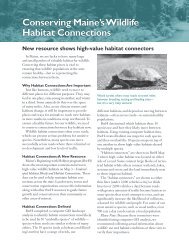
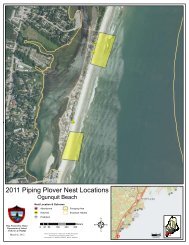
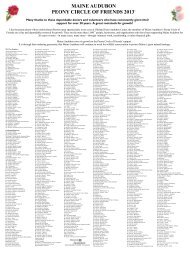
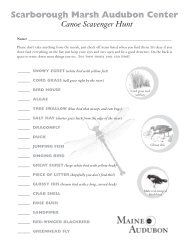

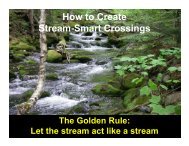
![2012 Loon Count Results [pdf] - Maine Audubon](https://img.yumpu.com/26228732/1/190x245/2012-loon-count-results-pdf-maine-audubon.jpg?quality=85)
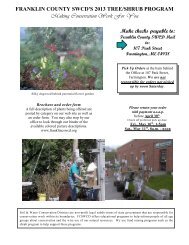
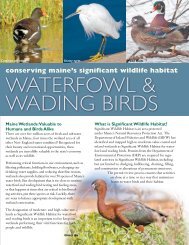
![Lake Fish of Maine (DIFW list) [pdf] - Maine Audubon](https://img.yumpu.com/23282964/1/190x245/lake-fish-of-maine-difw-list-pdf-maine-audubon.jpg?quality=85)
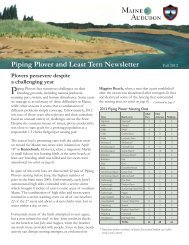

![The Maine Audubon Peony Circle of Friends 2012 [pdf]](https://img.yumpu.com/22707677/1/190x253/the-maine-audubon-peony-circle-of-friends-2012-pdf.jpg?quality=85)
